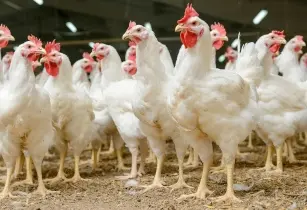Laying hens and broilers perform best within a temperature range of 11-26°C. The behavioural and physiological changes that occur with progressive temperature increases beyond the top end of this range are well documented
The effect of rising ambient air temperature on the physiology of poultry cannot be considered in isolation. When high humidity (over 75 per cent) accompanies high temperature, birds will rapidly succumb to, and die from, heat prostration. Birds lack sweat glands but lose water from facial appendages and by panting. But at high humidity, when the atmosphere of the house is saturated with water vapour, liquid water excreted by the birds fails to evaporate and therefore cannot provide its normal natural cooling effect. Air movement, natural or artificial, alleviates the situation by blowing the air, which is saturated with water vapour, away from the birds, thus allowing water on the surface of their bodies to evaporate with a resultant cooling effect.
Feeding, ingestion and digestion all generate heat which may be useful for birds at low temperature but they just aggravate heat stress for birds at high temperatures. As such, it is hardly surprising that birds react to high temperatures by reducing their feed intake. This poses the question as to whether accompanying losses in production – eggs decreasing in size, weight and shell strength – are due to heat stress per se or lack of energy-rich feed ingredients, proteins and/or vital nutrients and vitamins. In actual fact, loss of productivity with increasing temperature over and above 26°C is due to a combination of both.
The rest of this article is on page 14 of the latest issue of African Farming: http://www.africanfarming.net/current-issue








